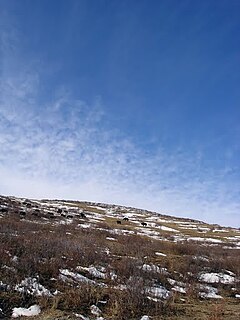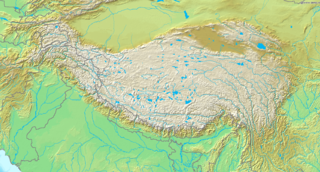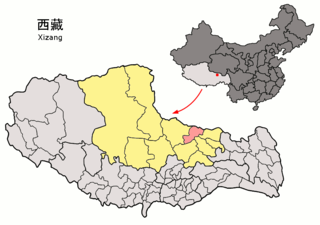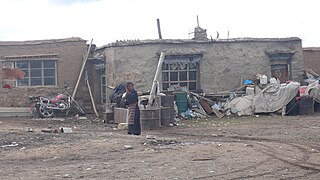
Qinghai, is a province of the People's Republic of China located in the northwest of the country. As one of the largest province-level administrative divisions of China by area, the province is ranked fourth-largest in area, and has the third-smallest population.

Qinghai Lake, Koko Nor or Tso Ngonpo is the largest lake in China. Located in Qinghai province on an endorheic basin, Qinghai Lake is classified as a saline and alkaline lake. Qinghai Lake has a surface area of 4,317 square kilometres (1,667 sq mi); an average depth of 21 metres (69 ft), and a maximum depth of 25.5 m (84 ft) as measured in 2008. The current Chinese name "Qinghai," the older Mongolian name "Kokonor", and the Tibetan name translate to "Green Sea", "Blue Lake" and "Teal Sea", respectively. Qinghai Lake is located about 100 kilometres (62 mi) west of the provincial capital of Xining at 3,205 m (10,515 ft) above sea level in a hollow of the Tibetan plateau. Twenty-three rivers and streams empty into Qinghai Lake, most of them seasonal. Five permanent streams provide 80% of total influx.
Khams Tibetan is the Tibetic language used by the majority of the people in Kham, which is now divided between the eastern part of Tibet Autonomous Region, the southern part of Qinghai, the western part of Sichuan, and the northwestern part of Yunnan, China. It is one of the six main spoken Tibetic languages, the other five being Central Tibetan language, Amdo, Ladakhi, Dzongkha and Balti. These Tibetic languages share the same written script, but their pronunciations, vocabularies and grammars are different. These differences may have emerged due to geographical isolation of the regions of Tibet. Khams Tibetan is used alongside Standard Tibetan and Amdo Tibetan in broadcasting. Khams Tibetan is not mutually intelligible with other Tibetic languages.

GologTibetan Autonomous Prefecture is an autonomous prefecture occupying the southeastern corner of Qinghai province, People's Republic of China. The prefecture has an area of 76,312 km2 (29,464 sq mi) and its seat is located in Maqên County.
Salar is a Turkic language spoken by the Salar people, who mainly live in the provinces of Qinghai and Gansu in China; some also live in Ili, Xinjiang. It is an eastern outlier of the Oghuz branch of Turkic, the other Oghuz languages being spoken mostly in West-Central Asia. The Salar number about 105,000 people, about 70,000 (2002) speak the Salar language; under 20,000 monolinguals.

Geladaindong Peak is a snow-covered mountain located in southwestern Qinghai province of China near the border of Tibet Autonomous Region. It is the tallest mountain in the Tanggula Mountain Range of the Tibetan Plateau with an elevation of 6,621 metres (21,722 ft) above sea level. The traditional source of the Yangtze River, begins with glaciers on its surface. The Yangtze's true source, however, lies 325 km (202 mi) away at the head of the Dam Qu.

Nagqu Town, Nagchu in original Tibetan or Naqu, also known as Nagchuka or Nagquka, is a town in northern Tibet, seat of Nagqu, approximately 328 km (204 mi) by road north-east of the capital Lhasa, within the People's Republic of China.

Seni District is a district within the Nagqu of the Tibet Autonomous Region, western People's Republic of China.

Nyainrong County is a small county under the administration of the prefecture-level city of Nagqu, in the north of the Tibet Autonomous Region, bordering Qinghai province to the north. Yurla is a favourite of the people of the county.
The Amdolese language is the Tibetic language spoken by the majority of Amdolese, mainly in Qinghai and some parts of Sichuan and Gansu.

The Ngolok rebellions (1917–1949) were a series of military campaigns against unconquered Ngolok (Golok) tribal Tibetan areas of Qinghai (Amdo), undertaken by two Hui commanders, Gen. Ma Qi and Gen. Ma Bufang, on behalf of the Beiyang and Kuomintang governments of the Republic of China. The campaigns lasted between 1917 and 1949.
P. Matthias Hermanns was a missionary of the SVD and a German Tibetologist.

The Bangong suture zone is approximately 1200 km long and trends in an east–west orientation, and a key location in the central Tibet conjugate fault zone. Located in central Tibet between the Lhasa and Qiangtang terranes, it is a discontinuous belt of ophiolites and mélange that is 10–20 km wide, up to 50 km wide in places. The northern part of the fault zone consists of northeast striking sinistral strike-slip faults while the southern part consists of northwest striking right lateral strike-slip faults. These conjugate faults to the north and south of the Bangong intersect with each other along the Bangong-Nujiang suture zone.

Cona, also Dongaii Cona or Tsonag Lake, is a major lake of northern Tibet Autonomous Region, China and is It is located in Amdo County, west of the road between Nagqu Town and Amdo Town. The lake is considered holy to the Tibetans especially in the Bon religion, as it is seen as the "soul lake" of the Razheng Living Buddha. The smaller Ganong Lake lies almost adjacent to the southeast.

Pana, also Pagnag is a small town and township-level division of Amdo County in the Nagqu Prefecture of the Tibet Autonomous Region, in China. It is located just outside Amdo Town. As of 2004 it had a population of about 2700, 683 of which were living in the town of Pana. The principal economic activity is animal husbandry, pastoral yak, goat, sheep, and so on. Blueschist outcrops are found in the area. The villagers in recent times organized a railway protecting committee to select locals to monitor the Qinghai-Tibet Railway.

Yanshiping, also Yan Shi is a small town physically situated in the southwest of Qinghai province, China. However, it is under the jurisdiction of Amdo County in the Nagqu Prefecture of the Tibet Autonomous Region. At an elevation of 4,720 metres (15,490 ft), it is one of the highest year-round settlements in the world. The principal economic activity is animal husbandry.

High pressure terranes along the ~1200 km long east-west trending Bangong-Nujiang suture zone (BNS) on the Tibetan Plateau have been extensively mapped and studied. Understanding the geodynamic processes in which these terranes are created is key to understanding the development and subsequent deformation of the BNS and Eurasian deformation as a whole.
Chen Qingying, is a Chinese tibetologist. He is the director of the History Research Institute under the China Tibetology Research Center.

















